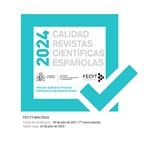Mácula e inserción social del expósito prohijado en Castilla. 1772-1832. (RI §426172)

Macula and social insertion of fostered foundings in Castile. 1772-1832 -
Pilar Calvo Caballero
La historiografía se ha centrado en el abandono de niños, poco sabemos del curso vital de los supervivientes, del impacto de su mácula, de la R. Cédula de 1794 de legitimidad civil de los expósitos y de su inserción. A través de veintiséis casos de prohijamiento de expósitos (informal el grueso) se rastrea cómo construyen su identidad, en la que padre e hijo son apelativos emocionales de la fuerza del afecto, con el apellido (aunque no se le dé) y honra del prohijador. Se rastrea su voz en busca de ascenso en sus solicitudes a la beneficencia privada, Administración, Rey y tribunales, a los que llega gracias a la protección de la Monarquía ilustrada. Identidad y legitimidad civil fueron el escudo contra su mácula, que decae entre vecinos y tribunales, que normalizan su identidad e integración, se fue venciendo la resistencia de estatutos de la Administración y órdenes religiosas, pero no la discriminación del mayorazgo por ilegítimo.
I. Lugares comunes y vacíos historiográficos. II. Ser expósito prohijado: ¿mácula o salvoconducto para el ascenso social? III. Actitudes sociales y cultura jurídica ante la integración del expósito prohijado. IV. Conclusiones. V. Fuentes. VI. Bibliografía.
Historiography has often focused on the abandonment of children, but little is known about the life course of the survivors, the impact of their blemish (macula), the Royal Ordinance of 1794 on the civil legitimacy of foundlings and their social insertion. Through twenty-six cases of foundlings' fostering (the bulk of which are informal), we trace how they constructed their identity, in which father and son were terms of endearment that conveyed the strength of affection and bestowed on the abandoned child the foster father’s surname (even if not given) and honourability. The foundlings’ voice in their quest for social advancement can be traced in petitions addressed to private benefactors, the Administration, the King and the courts of justice, which they reached out to thanks to the protection of the enlightened Monarchy. Identity and civil legitimacy were the shield that covered the foundlings’ stain, which gradually wore off among their neighbours and in the eyes of justice itself until their identity and social integration were normalised. In this way, the resistance of the Administration’s statutory procedures and of the religious orders was progressively overcome, but not the discrimination entailed by the right of primogeniture, which they were excluded from as illegitimate children.
I. Commonplaces and historiographical gaps. II. Being a foundling: a blemish or a safeguard for social advancement? III. Social attitudes and legal culture regarding the integration of fostered foundlings. IV. Conclusions. V. Sources. VI. Bibliography.
Documento disponible para usuarios registrados.
Para consultar gratuitamente este artículo primero deberá registrarse como usuario.

 DIRECTORA
DIRECTORA